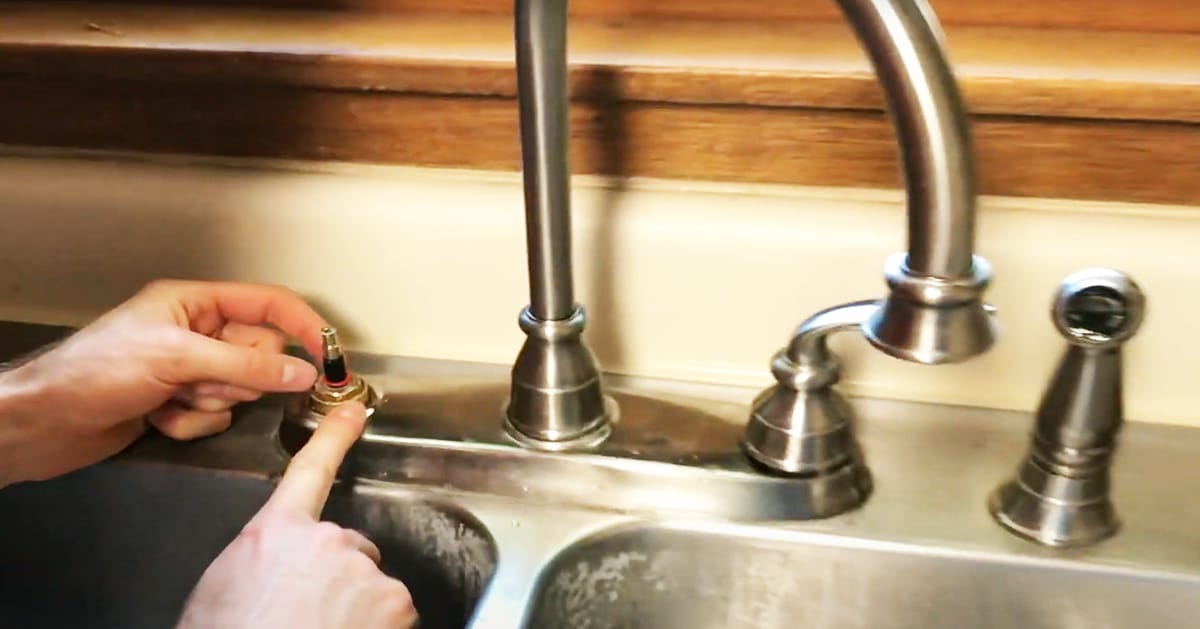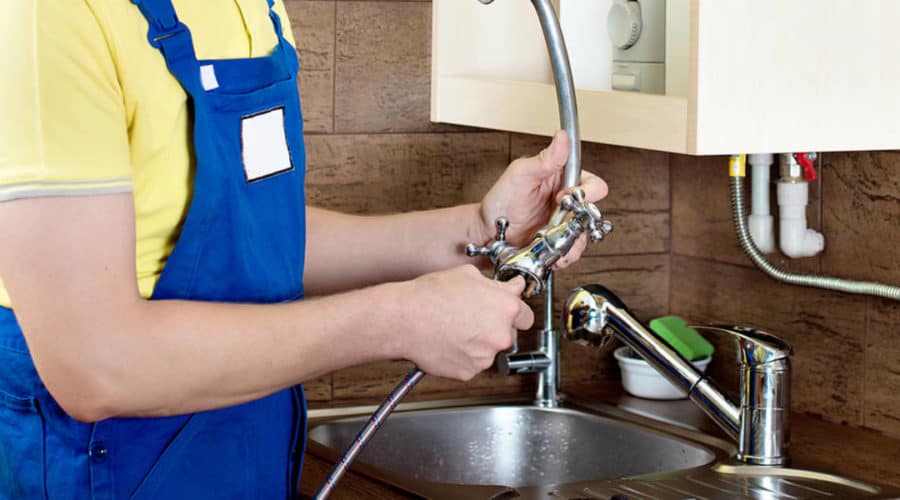A leaking kitchen faucet can be a source of significant frustration and inconvenience. Beyond the annoying drip-drip sound, a leak can waste a substantial amount of water, increase your utility bills, and potentially cause water damage to your sink area and cabinetry. Understanding the reasons behind a leaking faucet is the first step towards a solution. There are several common causes of faucet leaks, each requiring different approaches for repair.
One common cause of a leaking kitchen faucet is a worn-out washer. Washers are small discs that provide a tight seal in the valve seat, preventing water from flowing when the faucet is turned off. Over time, these washers can become stiff, torn, or dislodged, resulting in a leak. Replacing the washer usually resolves this issue, but it requires identifying the correct type and size of washer for your specific faucet model.

Another frequent cause of leaks is a damaged O-ring. The O-ring is a small rubber ring that fits around the valve stem and helps to seal the faucet. Like washers, O-rings can degrade over time due to wear and tear, exposure to water, and temperature fluctuations. When an O-ring is damaged, water can seep through the gaps, causing a leak. Replacing the O-ring is typically a straightforward repair that can stop the leak.
The valve seat itself can also be a source of leaks. The valve seat connects the faucet to the spout and provides a sealing surface for the washer. Over time, mineral deposits from hard water can build up on the valve seat, causing it to corrode or become pitted. This can prevent the washer from forming a tight seal, leading to leaks. Cleaning or replacing the valve seat can address this problem.
![]()
Cartridge faucets, which are common in modern kitchens, can develop leaks if the cartridge becomes worn or damaged. The cartridge is a cylindrical component that controls the flow of water through the faucet. When the cartridge is compromised, it can allow water to leak even when the faucet is turned off. Replacing the cartridge is often the best solution, and many hardware stores sell replacement cartridges that fit a variety of faucet models.
Ball faucets, which use a single handle to control both the temperature and flow of water, can develop leaks due to wear and tear on the internal components, such as the ball, springs, and seals. These faucets have a complex mechanism that can be more challenging to repair compared to other types. Often, replacing the entire ball assembly or the springs and seals can resolve the leak.

Compression faucets, which are older designs that use separate handles for hot and cold water, can leak if the seals or washers wear out. These faucets work by compressing a rubber washer against a valve seat to stop the flow of water. Over time, the repetitive compression can cause the washers to deteriorate, leading to leaks. Replacing the washers and, if necessary, the valve seat can fix this issue.
Loose or damaged faucet parts can also cause leaks. For example, if the packing nut, which holds the faucet handle in place, becomes loose, water can leak around the handle. Tightening the packing nut can often stop the leak. In some cases, parts like the spout or handles may need to be replaced if they are damaged beyond repair.
Inadequate installation or improper maintenance can lead to leaks. If a faucet is not installed correctly, the seals and connections may not be tight enough, allowing water to escape. Regular maintenance, such as cleaning aerators and checking for loose parts, can help prevent leaks from developing. Ensuring that the faucet is properly installed and maintained can significantly reduce the likelihood of leaks.

High water pressure can contribute to faucet leaks. If the water pressure in your home is too high, it can put excessive stress on the faucet components, causing them to wear out more quickly and develop leaks. Installing a pressure-reducing valve can help manage high water pressure and prolong the life of your faucet.
Freezing temperatures can also cause faucets to leak. When water inside the faucet freezes, it expands, which can cause cracks in the faucet body or damage to the internal components. To prevent this, it’s important to insulate pipes and ensure that faucets are properly winterized in cold climates.
Mineral buildup from hard water can clog and damage faucet components, leading to leaks. Regular cleaning and descaling can help prevent this. Installing a water softener can also reduce mineral buildup and extend the life of your faucets.

Age and general wear and tear are inevitable causes of faucet leaks. Over time, even the best-maintained faucets will degrade and require repair or replacement. Regular inspection and prompt attention to any leaks can help manage this issue and prolong the lifespan of your faucet.
Improper use or excessive force can damage faucet components and cause leaks. For instance, turning the handles too tightly can damage the washers and seals. Educating household members on the correct use of the faucet can help prevent unnecessary wear and tear.
Manufacturing defects, while less common, can also be a cause of faucet leaks. If a new faucet begins leaking soon after installation, it may be due to a defect in the materials or construction. In such cases, contacting the manufacturer for a replacement or refund is often the best course of action.
Regular inspection and maintenance of your kitchen faucet can help prevent leaks and extend its lifespan. Checking for signs of wear and tear, cleaning aerators, and ensuring that all parts are securely fastened can help keep your faucet in good working condition.

Common Mistakes to Avoid:
When dealing with a leaking kitchen faucet, there are several common mistakes that can complicate the repair process or even worsen the problem. One frequent mistake is neglecting to turn off the water supply before attempting repairs. Failing to do so can result in a messy and potentially damaging situation.
Another mistake is using the wrong tools or replacement parts. It’s essential to use the correct size and type of washers, O-rings, and other components specific to your faucet model.
Over-tightening parts is another common error. While it might seem like tightening components as much as possible would prevent leaks, it can actually damage washers and seals, making the problem worse. Conversely, under-tightening can leave connections too loose, failing to stop the leak. Proper installation techniques and an understanding of the appropriate tightness levels are crucial.
Ignoring the manufacturer’s instructions can also lead to problems. Each faucet model has specific repair guidelines, and deviating from these can result in ineffective repairs or further damage. Additionally, failing to address mineral buildup can lead to recurring leaks. Regular cleaning and descaling are important maintenance steps that should not be overlooked.

What should I do if my kitchen faucet is leaking from the base?
If your kitchen faucet is leaking from the base, the first step is to check for any loose connections. Tighten the mounting nuts and any other connections under the sink. If the leak persists, it may be due to a worn-out O-ring or seal within the faucet assembly. Disassembling the faucet and replacing the damaged O-ring or seal should resolve the issue. It’s important to ensure the water supply is turned off before attempting any repairs.
Why is my kitchen faucet dripping when turned off?
A dripping kitchen faucet when turned off is often caused by a worn-out washer or cartridge. In compression faucets, the washer may have become stiff or damaged, preventing it from forming a tight seal. In cartridge faucets, the cartridge itself may be worn or damaged. Replacing the faulty washer or cartridge usually stops the dripping. Identifying the type of faucet you have and obtaining the correct replacement part is essential for a successful repair.
Can high water pressure cause my kitchen faucet to leak?
Yes, high water pressure can cause a kitchen faucet to leak. Excessive water pressure puts extra stress on the faucet components, leading to faster wear and tear. This can result in leaks around the handles, spout, or base of the faucet. Installing a pressure-reducing valve can help manage high water pressure and reduce the strain on your faucet, preventing leaks and prolonging its lifespan.

How do I prevent mineral buildup in my kitchen faucet?
To prevent mineral buildup in your kitchen faucet, regular cleaning and maintenance are essential. Removing and soaking the aerator in vinegar can help dissolve mineral deposits. For more extensive buildup, disassembling the faucet and soaking the affected parts in a vinegar solution can be effective. Installing a water softener can also help reduce the mineral content in your water, preventing buildup and extending the life of your faucet.
What are the signs that my faucet needs to be replaced rather than repaired?
Signs that your faucet may need to be replaced rather than repaired include persistent leaks despite repeated repairs, visible corrosion or damage to the faucet body, and outdated or inefficient design. If the internal components are severely worn or if the faucet is over 15 years old, replacement may be more cost-effective and beneficial. Additionally, frequent leaks and ongoing maintenance issues can be a sign that it’s time for an upgrade.
How can I winterize my kitchen faucet to prevent leaks?
To winterize your kitchen faucet and prevent leaks caused by freezing temperatures, start by insulating any exposed pipes. Use pipe insulation sleeves or heat tape to protect the pipes from freezing. If you have an outdoor faucet or a faucet located in an unheated area, shut off the water supply to that faucet and drain any remaining water. Additionally, consider leaving the faucet slightly open during extremely cold weather to allow water to flow and prevent pressure buildup.

Moen Kitchen Faucet Broken Lever Handle Repair

How to Fix a Leaky Faucet

Related Posts:
- Country Kitchen Faucets
- Dual Faucet Kitchen Sink
- Clearance Kitchen Sinks And Faucets
- Kohler Kitchen Faucet Handle
- Peerless Kitchen Faucet Diverter
- What Is A Kitchen Faucet
- Grohe K4 Kitchen Faucet Parts
- Brizo Tresa Bridge Kitchen Faucet
- Glacier Bay Single Handle Pull Out Sprayer Kitchen Faucet
- White Kitchen Faucet Moen